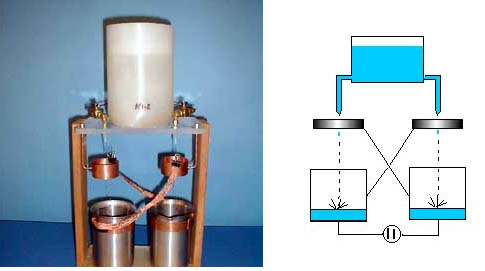Demos: 5A-05 Kelvin Water Dropper

Two smooth water jets flowing down from a common tank break into droplets within metal collars, and the drops fall into metal cans, insulated from the table top. Each collar is connected to the opposite can, as illustrated. Differing effects of ionized air drifting past the cans insures an initial difference of potential. If, for example, the right hand can becomes momentarily positive, its connected collar becomes positive also. The other can and collar then become negative. The jets of water and the supply tank nozzle form a continuous conductor. The charges on the collar induce opposite charges on the ends of the jets. When the jets break up into droplets, these droplets are charged opposite to the collar and will transfer these charges to the can underneath. Once started, the charges build up very rapidly. One terminal of a neon lamp (or several in series) is attached to one base base plate while the other is approximately 1/8 to 1/4 inch from the other plate. The voltage can build up to 5,000 V or more causing the tube(s) to flash.
Directions: Most adjustments are made ahead of time by the staff, except for the flow. This demonstration usually works well, but careful adjustments are necessary for a good result. Open the spigots that start the flow in the pipes. Adjust the flow so that the water droplets begin to form at a height just inside the ring. Dim the room lights and wait. Flashes of light in the neon bulbs typically start to occur after about 30 seconds.
Suggestions for Presentation: Although many electrostatic effects are somewhat obvious, this one is not. The crucial point is how the rings and cans get charged initially. You might defer discussion of the effect of drifting ions until the demonstration is complete, or you can introduce it up front.
One effect in this demonstration is easily overlooked. As the drops fall through the rings, the charges build up rapidly to the point that the droplets often repel each other vigorously, resulting in a kind of “spraying” effect around the rings. You might aim the video camera on one of the rings to show this effect more clearly to the entire class.
Applications: None
Last Updated: Nov 30, 2023 11:25 AM